Walker J. Facies models, Canada, 1992
Подождите немного. Документ загружается.

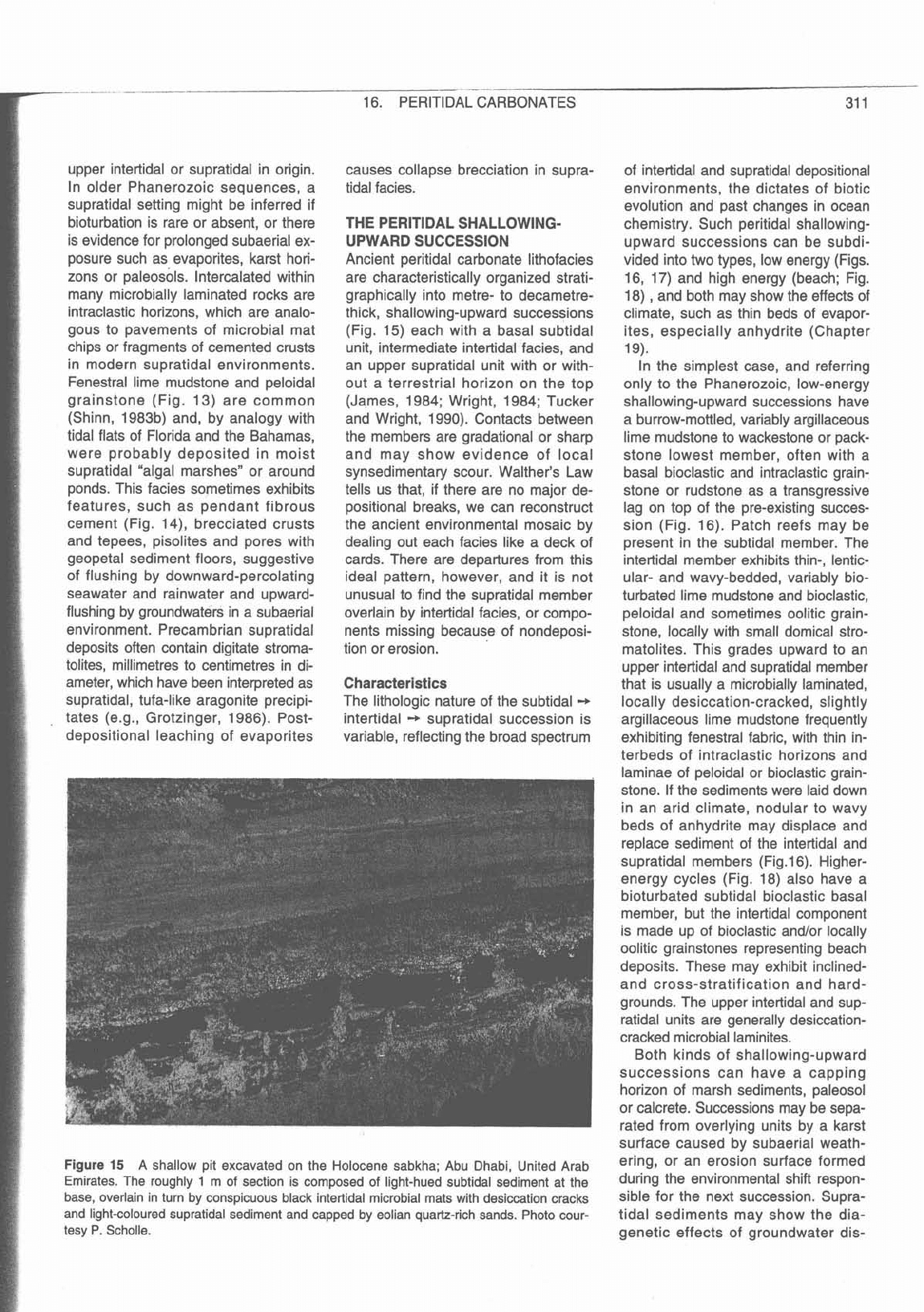
-
.
..
.-
-
-
.
-
-
-
.-
.
16. PERlTlDAL CARBONATES 31 1
upper intertidal or supratidal in origin.
In older Phanerozoic sequences, a
supratidal setting might be inferred if
bioturbation is rare or absent, or there
is evidence for prolonged subaerial ex-
posure such as evaporites, karst hori-
zons or paleosols. Intercalated within
many microbially laminated rocks are
intraclastic horizons, which are analo-
gous to pavements of microbial mat
chips or fragments of cemented crusts
in modern supratidal environments.
Fenestral lime
mudstone and peloidal
grainstone (Fig. 13) are common
(Shinn,
198313) and, by analogy with
tidal flats of Florida and the Bahamas,
were probably deposited in moist
supratidal "algal marshes" or around
ponds. This facies sometimes exhibits
features, such as pendant fibrous
cement (Fig.
14), brecciated crusts
and tepees, pisolites and pores with
geopetal sediment floors, suggestive
of flushing by downward-percolating
seawater and rainwater and
upward-
flushing by groundwaters in a subaerial
environment. Precambrian supratidal
deposits often contain
digitate stroma-
tolites, millimetres to centimetres in di-
ameter, which have been interpreted as
supratidal, tufa-like aragonite precipi-
tates
(e.g., Grotzinger, 1986). Post-
depositional leaching of evaporites
causes collapse brecciation in
supra-
tidal facies.
THE PERlTlDAL SHALLOWING-
UPWARD SUCCESSION
Ancient peritidal carbonate lithofacies
are characteristically organized
strati-
graphically into metre- to decametre-
thick, shallowing-upward successions
(Fig.
15)
each with a basal subtidal
unit, intermediate intertidal facies, and
an upper supratidal unit with or with-
out a terrestrial horizon on the top
(James, 1984; Wright, 1984; Tucker
and Wright, 1990). Contacts between
the members are gradational or sharp
and may show evidence of local
synsedimentary scour. Walther's Law
tells us that, if there are no major de-
positional breaks, we can reconstruct
the ancient environmental mosaic by
dealing out each facies like a deck of
cards. There are departures from this
ideal pattern, however, and it is not
unusual to find the supratidal member
overlain by intertidal facies, or compo-
nents missing because of
nondeposi-
tion or erosion.
Characteristics
The lithologic nature of the subtidal
-,
intertidal
-,
supratidal succession is
variable, reflecting the broad spectrum
of intertidal and supratidal depositional
environments, the dictates of biotic
evolution and past changes in ocean
chemistry. Such peritidal
shallowing-
upward successions can be subdi-
vided into two types, low energy (Figs.
16, 17) and high energy (beach; Fig.
18)
,
and both may show the effects of
climate, such as thin beds of
evapor-
ites, especially anhydrite (Chapter
19).
In the simplest case, and referring
only to the Phanerozoic, low-energy
shallowing-upward successions have
a burrow-mottled, variably argillaceous
lime
mudstone to wackestone or pack-
stone lowest member, often with a
basal bioclastic and intraclastic grain-
stone or rudstone as a transgressive
lag on top of the pre-existing succes-
sion (Fig. 16). Patch reefs may be
present in the
subtidal member. The
intertidal member exhibits
thin-, lentic-
ular- and wavy-bedded, variably
bio-
turbated lime mudstone and bioclastic,
peloidal and sometimes oolitic grain-
stone, locally with small domical
stro-
matolites. This grades upward to an
upper intertidal and supratidal member
that is usually a microbially laminated,
locally desiccation-cracked, slightly
argillaceous lime
mudstone frequently
exhibiting fenestral fabric, with thin
in-
terbeds of intraclastic horizons and
laminae of peloidal or bioclastic grain-
stone. If the sediments were laid down
in an arid climate, nodular to wavy
beds of anhydrite may displace and
replace sediment of the intertidal and
supratidal members
(Fig.16). Higher-
energy cycles (Fig. 18) also have a
bioturbated
subtidal bioclastic basal
member, but the intertidal component
is made up of bioclastic
andlor locally
oolitic grainstones representing beach
deposits. These may exhibit
inclined-
and cross-stratification and hard-
grounds. The upper intertidal and sup-
ratidal units are generally desiccation-
cracked microbial laminites.
Both kinds of shallowing-upward
successions can have a capping
horizon of marsh sediments,
paleosol
or calcrete. Successions may be sepa-
rated from overlying units by a karst
surface caused by subaerial weath-
Figure
15
A shallow pit excavated on the Holocene sabkha; Abu Dhabi, United Arab
ering~
Or
an
surface
Emirates. The roughly
1
m of section is composed of light-hued subtidal sediment at the
during the environmental shift respon-
base, overlain in turn by conspicuous black intertidal microbial mats with desiccation
cracks
sible for the next
SUCC~SS~O~.
Supra-
and light-coloured supratidal sediment and capped by eolian quartz-rich sands. Photo cour-
tidal sediments may show the dia-
tesy
P.
Scholle.
genetic effects of groundwater dis-
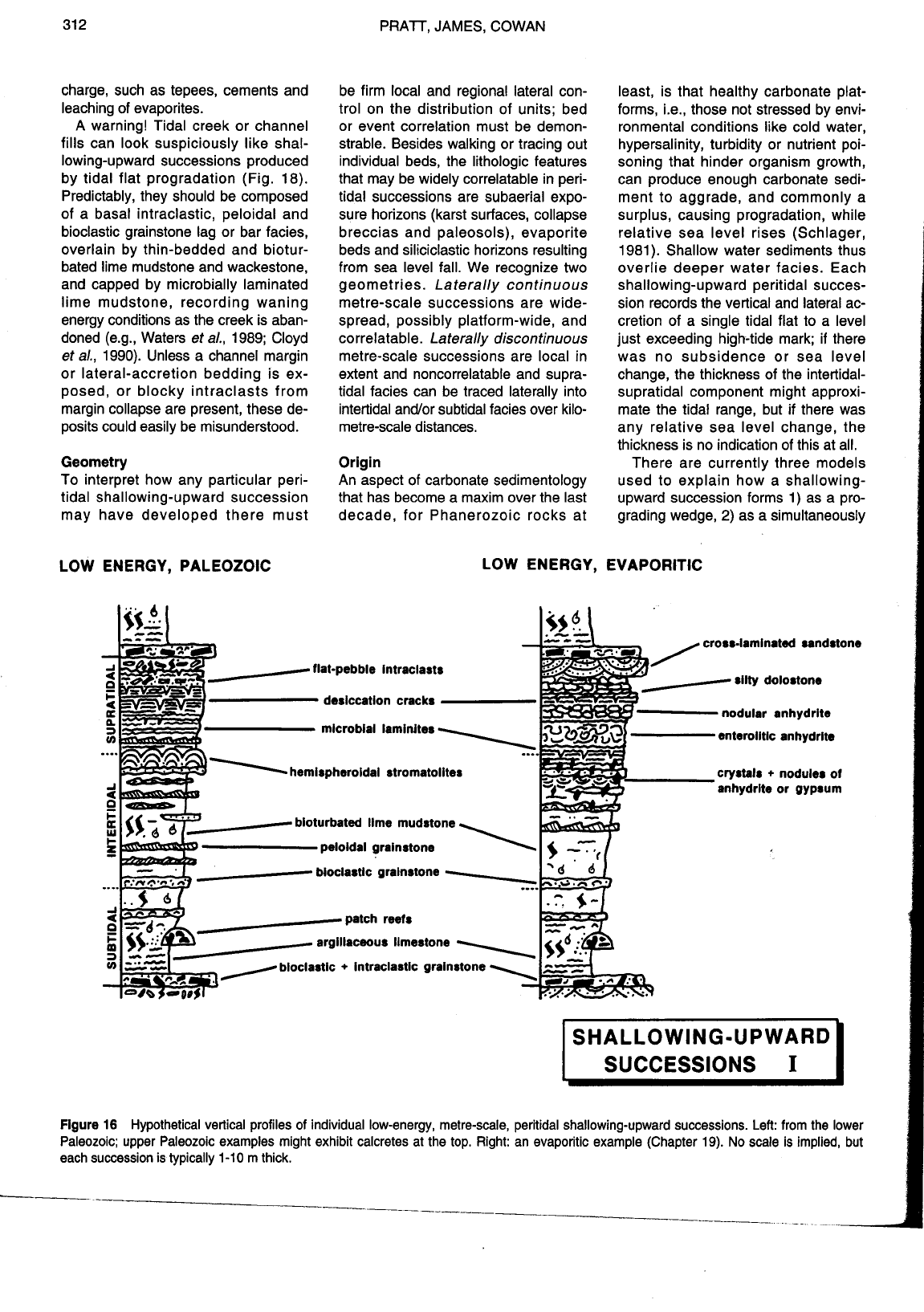
31 2 PRATT, JAMES, COWAN
charge, such as tepees, cements and
leaching of evaporites.
A warning! Tidal creek or channel
fills can look suspiciously like
shal-
lowing-upward successions produced
by tidal flat progradation (Fig. 18).
Predictably, they should be composed
of a basal intraclastic, peloidal and
bioclastic grainstone lag or bar facies,
overlain by thin-bedded and
biotur-
bated lime mudstone and wackestone,
and capped by microbially laminated
lime mudstone, recording waning
energy conditions as the creek is aban-
doned
(e.g., Waters
et al.,
1989; Cloyd
et al.,
1990). Unless a channel margin
or lateral-accretion bedding is ex-
posed, or blocky intraclasts from
margin collapse are present, these de-
posits could easily be misunderstood.
Geometry
To interpret how any particular peri-
tidal shallowing-upward succession
may have developed there must
be firm local and regional lateral con-
trol on the distribution of units; bed
or event correlation must be demon-
strable. Besides walking or tracing out
individual beds, the lithologic features
that may be widely correlatable in peri-
tidal successions are subaerial expo-
sure horizons (karst surfaces, collapse
breccias and paleosols), evaporite
beds and siliciclastic horizons resulting
from sea level fall. We recognize two
geometries.
Laterally continuous
metre-scale successions are wide-
spread, possibly platform-wide, and
correlatable.
Laterally discontinuous
metre-scale successions are local in
extent and noncorrelatable and
supra-
tidal facies can be traced laterally into
intertidal
andlor subtidal facies over kilo-
metre-scale distances.
Origin
An aspect of carbonate sedimentology
that has become a maxim over the last
decade, for Phanerozoic rocks at
least, is that healthy carbonate plat-
forms,
i.e., those not stressed by envi-
ronmental conditions like cold water,
hypersalinity, turbidity or nutrient poi-
soning that hinder organism growth,
can produce enough carbonate sedi-
ment to aggrade, and commonly a
surplus, causing progradation, while
relative sea level rises (Schlager,
1981). Shallow water sediments thus
overlie deeper water facies. Each
shallowing-upward peritidal succes-
sion records the vertical and lateral ac-
cretion of a single tidal flat to a level
just exceeding high-tide mark; if there
was no subsidence or sea level
change, the thickness of the
intertidal-
supratidal component might approxi-
mate the tidal range, but if there was
any relative sea level change, the
thickness is no indication of this at all.
There are currently three models
used to explain how a
shallowing-
upward succession forms 1) as a pro-
grading wedge, 2) as a simultaneously
LOW ENERGY, PALEOZOIC
LOW ENERGY,
EVAPORlTlC
cross-laminated sandstone
flat-pebble lntraclasts
silty dolostone
desiccation cracks
nodular anhydrlte
microbial
laminiter
enterolltlc anhydrlte
1
hemispheroidal stromatolltes
crystals
+
nodules of
anhydrlte or gypsum
bioturbated lime
mudstone
peloldal grainstone
-
biociastlc grainstone
argillaceous limestone
stic
+
lntraclastlc grain
SHALLOWING-UPWARD
I
SUCCESSIONS
I
I
Figure
16
Hypothetical vertical profiles of individual low-energy, metre-scale, peritidal shallowing-upward successions. Left: from the lower
Paleozoic; upper Paleozoic examples might exhibit calcretes at the top. Right: an evaporitic example (Chapter
19).
No scale is implied, but
each succession is typically
1-10
m thick.
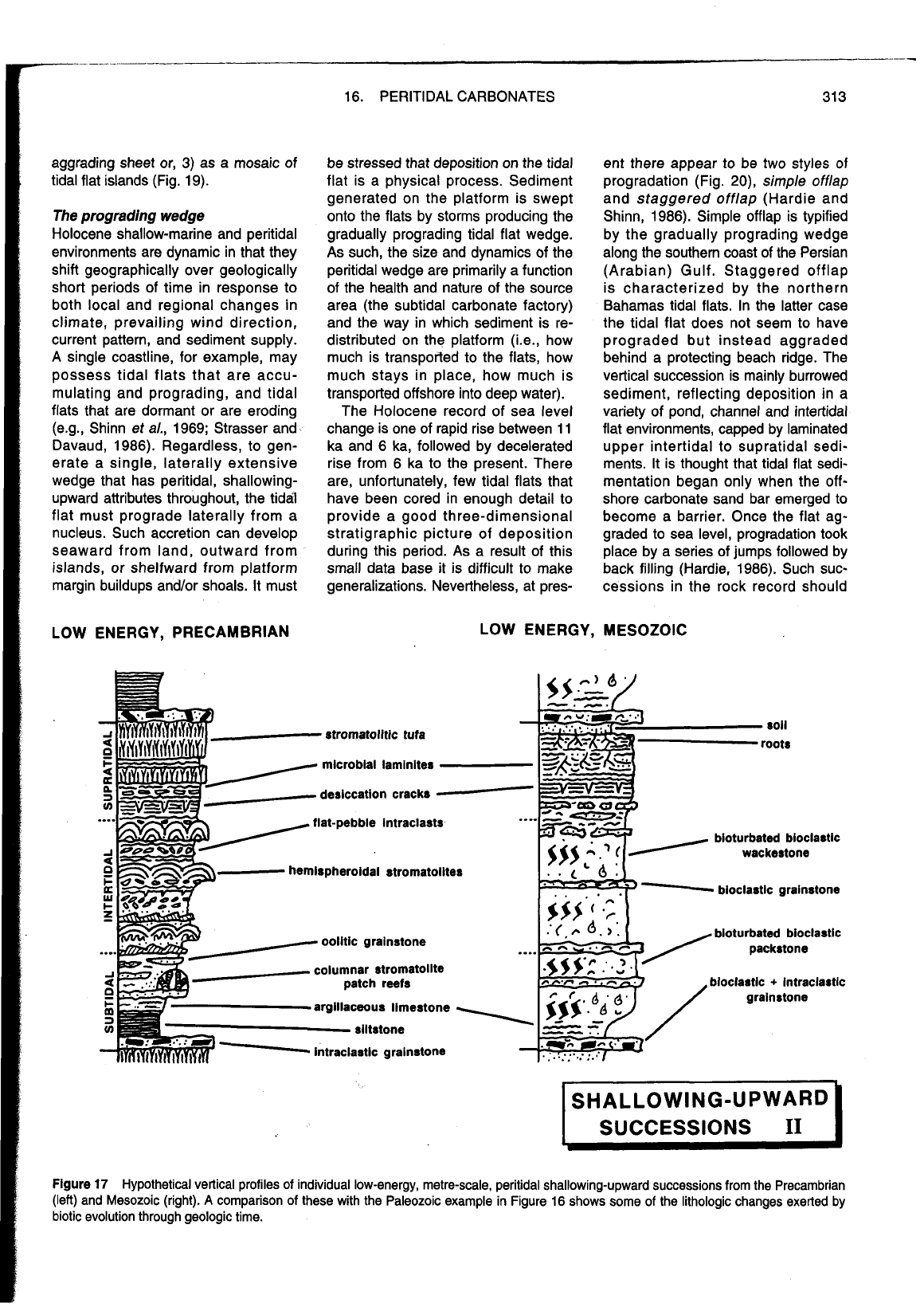
16. PERlTlDAL CARBONATES 31
3
aggrading sheet or,
3)
as a mosaic of
tidal flat islands (Fig. 19).
The prograding wedge
Holocene shallow-marine and peritidal
environments are dynamic in that they
shift geographically over geologically
short periods of time in response to
both local and regional changes in
climate, prevailing wind direction,
current pattern, and sediment supply.
A single coastline, for example, may
possess tidal flats that are accu-
mulating and prograding, and tidal
flats that are dormant or are eroding
(e.g., Shinn et a/., 1969; Strasser and
Davaud, 1986). Regardless, to gen-
erate a single, laterally extensive
wedge that has peritidal,
shallowing-
upward attributes throughout, the tidal
flat must
prograde laterally from a
nucleus. Such accretion can develop
seaward from land, outward from
islands, or shelfward from platform
margin buildups
andlor shoals. It must
be stressed that deposition on the tidal
flat is a physical process. Sediment
generated on the platform is swept
onto the flats by storms producing the
gradually prograding tidal flat wedge.
As such, the size and dynamics of the
peritidal wedge are primarily a function
of the health and nature of the source
area (the
subtidal carbonate factory)
and the way in which sediment is re-
distributed on the platform
(i.e., how
much is transported to the flats, how
much stays in place, how much is
transported offshore into deep water).
The Holocene record of sea level
change is one of rapid rise between 1 1
ka and 6 ka, followed by decelerated
rise from 6 ka to the present. There
are, unfortunately, few tidal flats that
have been cored in enough detail to
provide a good three-dimensional
stratigraphic picture of deposition
during this period. As a result of this
small data base it is difficult to make
generalizations. Nevertheless, at pres-
ent there appear to be two styles of
progradation (Fig.
20),
simple offlap
and staggered offlap (Hardie and
Shinn, 1986). Simple
offlap is typified
by the gradually prograding wedge
along the southem coast of the Persian
(Arabian) Gulf. Staggered
offlap
is characterized by the northern
Bahamas tidal flats. In the latter case
the tidal flat does not seem to have
prograded but instead aggraded
behind a protecting beach ridge. The
vertical succession is mainly burrowed
sediment, reflecting deposition in a
variety of pond, channel and intertidal
flat environments, capped by laminated
upper intertidal to supratidal sedi-
ments. It is thought that tidal flat sedi-
mentation began only when the off-
shore carbonate sand bar emerged to
become a barrier. Once the flat
ag-
graded to sea level, progradation took
place by a series of jumps followed by
back filling (Hardie, 1986). Such suc-
cessions in the rock record should
LOW ENERGY, PRECAMBRIAN
LOW ENERGY, MESOZOIC
stromatolitic tufa
microbial laminites
desiccation cracks
-
flat-pebble intraclasts
bioturbated bioclastlc
wackestone
-
bioclastic grainstone
oolitic grainstone
columnar stromatollte
argillaceous limestone
-
intraclastic grainstone
SHALLOWING-UPWARD
WI
Figure
17
Hypothetical vertical profiles of individual low-energy, metre-scale, peritidal shallowing-upward successions from the Precambrian
(left) and Mesozoic (right).
A
comparison of these with the Paleozoic example in Figure
16
shows some of the lithologic changes exerted by
biotic evolution through geologic time.
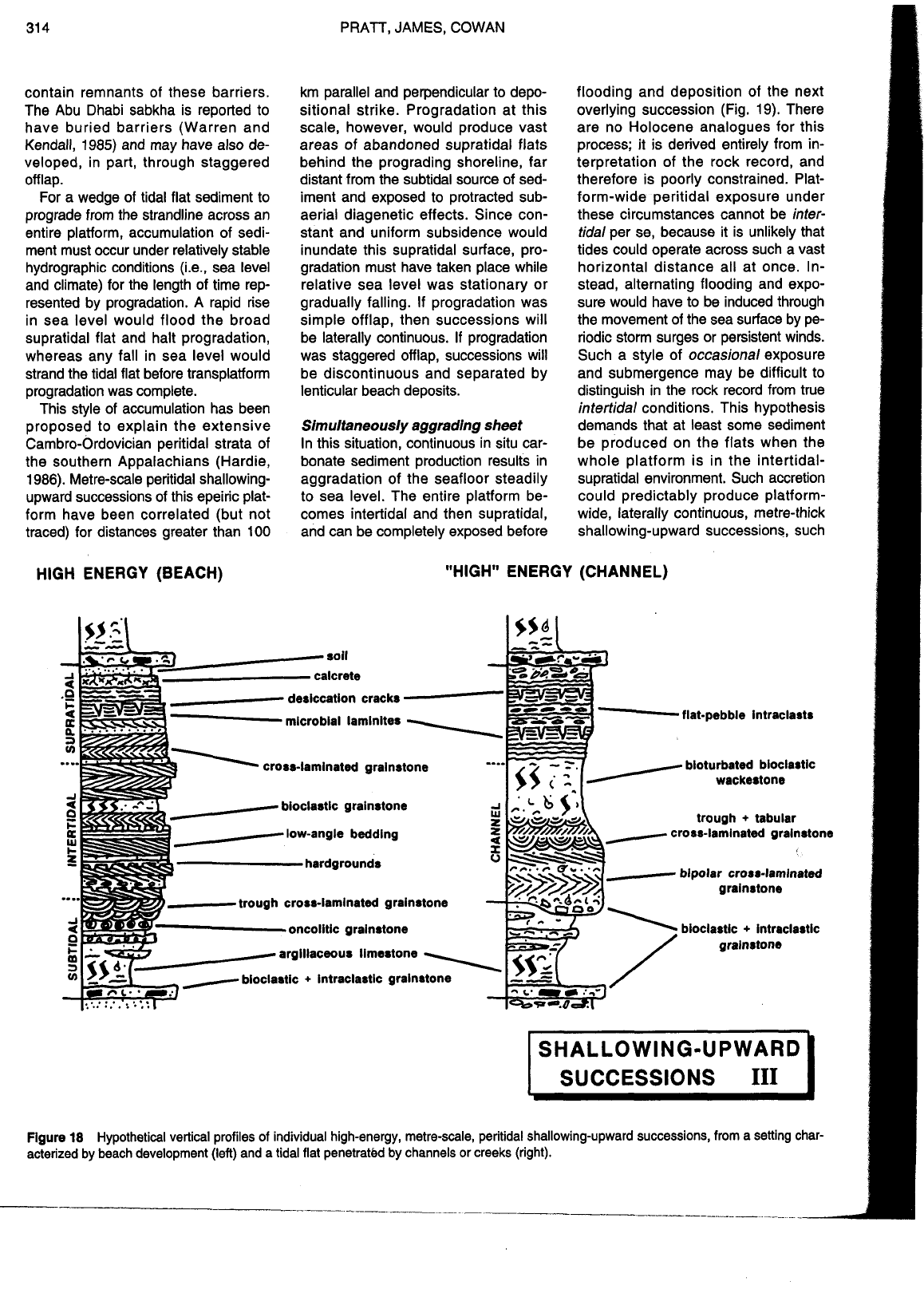
31
4
PRATT, JAMES, COWAN
contain remnants of these barriers.
The Abu Dhabi sabkha is reported to
have buried barriers (Warren and
Kendall, 1985) and may have also de-
veloped, in part, through staggered
offlap.
For a wedge of tidal flat sediment to
prograde from the strandline across an
entire platform, accumulation of sedi-
ment must occur under relatively stable
hydrographic conditions
(i.e., sea level
and climate) for the length of time rep-
resented by progradation. A rapid rise
in sea level would flood the broad
supratidal flat and halt progradation,
whereas any fall in sea level would
strand the tidal flat before transplatform
progradation was complete.
This style of accumulation has been
proposed to explain the extensive
Cambro-Ordovician peritidal strata of
the southern Appalachians (Hardie,
1986). Metre-scale peritidal
shallowing-
upward successions of this epeiric plat-
form have been correlated (but not
traced) for distances greater than 100
km parallel and perpendicular to depo-
sitional strike. Progradation at this
scale, however, would produce vast
areas of abandoned supratidal flats
behind the prograding shoreline, far
distant from the
subtidal source of sed-
iment and exposed to protracted
sub-
aerial diagenetic effects. Since con-
stant and uniform subsidence would
inundate this supratidal surface,
pro-
gradation must have taken place while
relative sea level was stationary or
gradually falling. If progradation was
simple
offlap, then successions will
be laterally continuous.
If
progradation
was staggered off lap, successions will
be discontinuous and separated by
lenticular beach deposits.
Simultaneously aggrading sheet
In this situation, continuous in situ car-
bonate sediment production results in
aggradation of the
seafloor steadily
to sea level. The entire platform be-
comes intertidal and then supratidal,
and can be completely exposed before
flooding and deposition of the next
overlying succession (Fig. 19). There
are no Holocene analogues for this
process; it is derived entirely from in-
terpretation of the rock record, and
therefore is poorly constrained. Plat-
form-wide peritidal exposure under
these circumstances cannot be inter-
tidal per se, because it is unlikely that
tides could operate across such a vast
horizontal distance all at once. In-
stead, alternating flooding and expo-
sure would have to be induced through
the movement of the sea surface by pe-
riodic storm surges or persistent winds.
Such a style of occasional exposure
and submergence may be difficult to
distinguish in the rock record from true
intertidal conditions. This hypothesis
demands that at least some sediment
be produced on the flats when the
whole platform is in the
intertidal-
supratidal environment. Such accretion
could predictably produce
platform-
wide, laterally continuous, metre-thick
shallowing-upward successions, such
HIGH ENERGY (BEACH)
"HIGH" ENERGY (CHANNEL)
-
microbial laminites
-
flat-pebble intraclasts
cross-laminated
grainrtone
bioturbated biociastic
wackertone
bioclastic grainrtone
trough
+
tabular
low-angle bedding
-
cross-laminated grainrtone
bipolar
crorr-laminated
gralnrtone
-trough cross-laminated grainstone
oncolitic grainstone
ioclastic
+
intraclartic
grainstone
argillaceous
limestone
rtlc
+
intraclastic grain
SHALLOWING-UPWARD
SUCCESSIONS
I11
1
Figure
18
Hypothetical vertical profiles of individual high-energy, metre-scale, peritidal shallowing-upward successions, from a setting char-
acterized by beach development (left) and a tidal flat penetrated by channels or creeks (right).
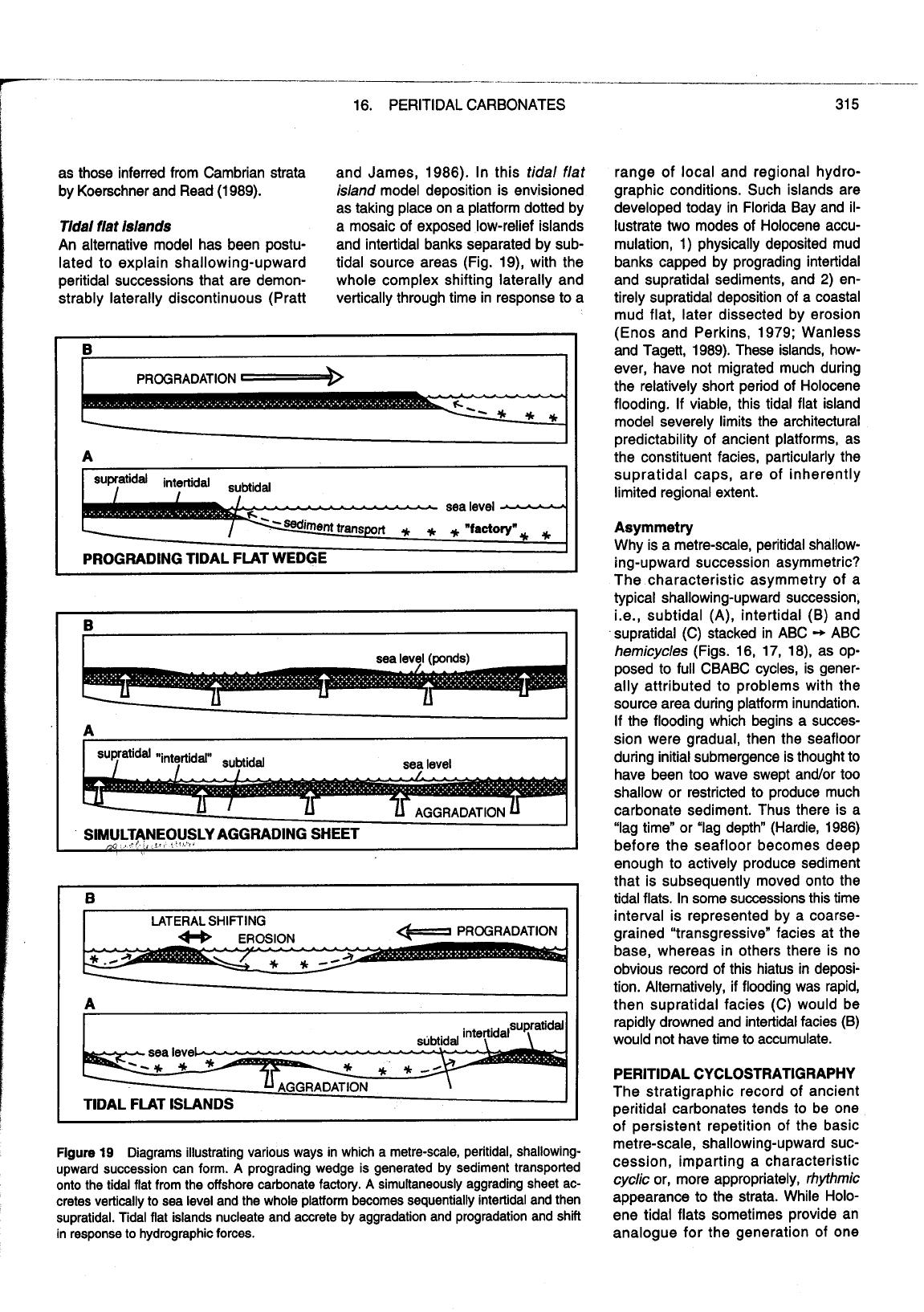
I
16. PERlTlDAL CARBONATES
as those inferred from Cambrian strata
and James, 1986). In this
tidal flat
by Koerschner and Read
(1
989).
island
model deposition is envisioned
as taking place on a platform dotted by
Tidal flat islands
a mosaic of exposed low-relief islands
I
I
An alternative model has been postu-
and intertidal banks separated by sub-
lated to explain shallowing-upward
tidal source areas (Fig.
19), with the
I
peritidal successions that are demon-
whole complex shifting laterally and
strably laterally discontinuous (Pratt
vertically through time in response to a
B
SIMULTANEOUSLY AGGRADING SHEET
oQ
'
,,
.
$Lh,,
Figure
19
Diagrams illustrating various ways in which a metre-scale, peritidal, shallowing-
upward succession can form.
A
prograding wedge is generated by sediment transported
onto the tidal flat from the offshore carbonate factory.
A
simultaneously aggrading sheet ac-
cretes vertically to sea level and the whole platform becomes sequentially intertidal and then
supratidal. Tidal flat islands nucleate and
accrete by aggradation and progradation and shift
in response
to
hydrographic forces.
range of local and regional hydro-
graphic conditions. Such islands are
developed today in Florida Bay and il-
lustrate two modes of Holocene accu-
mulation,
1)
physically deposited mud
banks capped by prograding intertidal
and supratidal sediments, and
2)
en-
tirely supratidal deposition of a coastal
mud flat, later dissected by erosion
(Enos and
Perkins, 1979; Wanless
and Tagett, 1989). These islands, how-
ever, have not migrated much during
the relatively short period of Holocene
flooding. If viable, this tidal flat island
model severely limits the architectural
predictability of ancient platforms, as
the constituent facies, particularly the
supratidal caps, are of inherently
limited regional extent.
Asymmetry
Why is a metre-scale, peritidal shallow-
ing-upward succession asymmetric?
The characteristic asymmetry of a
typical shallowing-upward succession,
i.e., subtidal (A), intertidal
(B)
and
supratidal (C) stacked in ABC
-*
ABC
hemicycles
(Figs. 16, 17, 18), as op-
posed to full CBABC cycles, is gener-
ally attributed to problems with the
source area during platform inundation.
If the flooding which begins a succes-
sion were gradual, then the
seafloor
during initial submergence is thought to
have been too wave swept
and/or too
shallow or restricted to produce much
carbonate sediment. Thus there is a
"lag timen or "lag depth" (Hardie, 1986)
before the
seafloor becomes deep
enough to actively produce sediment
that is subsequently moved onto the
tidal flats. In some successions this time
interval is represented by a
coarse-
grained "transgressiven facies at the
base, whereas in others there is no
obvious record of this hiatus in deposi-
tion. Alternatively, if flooding was rapid,
then supratidal facies (C) would be
rapidly drowned and intertidal facies
(B)
would not have time to accumulate.
PERlTlDAL CYCLOSTRATIGRAPHY
The stratigraphic record of ancient
peritidal carbonates tends to be one
of persistent repetition of the basic
metre-scale, shallowing-upward suc-
cession, imparting a characteristic
cyclic
or, more appropriately,
rhythmic
appearance to the strata. While Holo-
ene tidal flats sometimes provide an
analogue for the generation of one
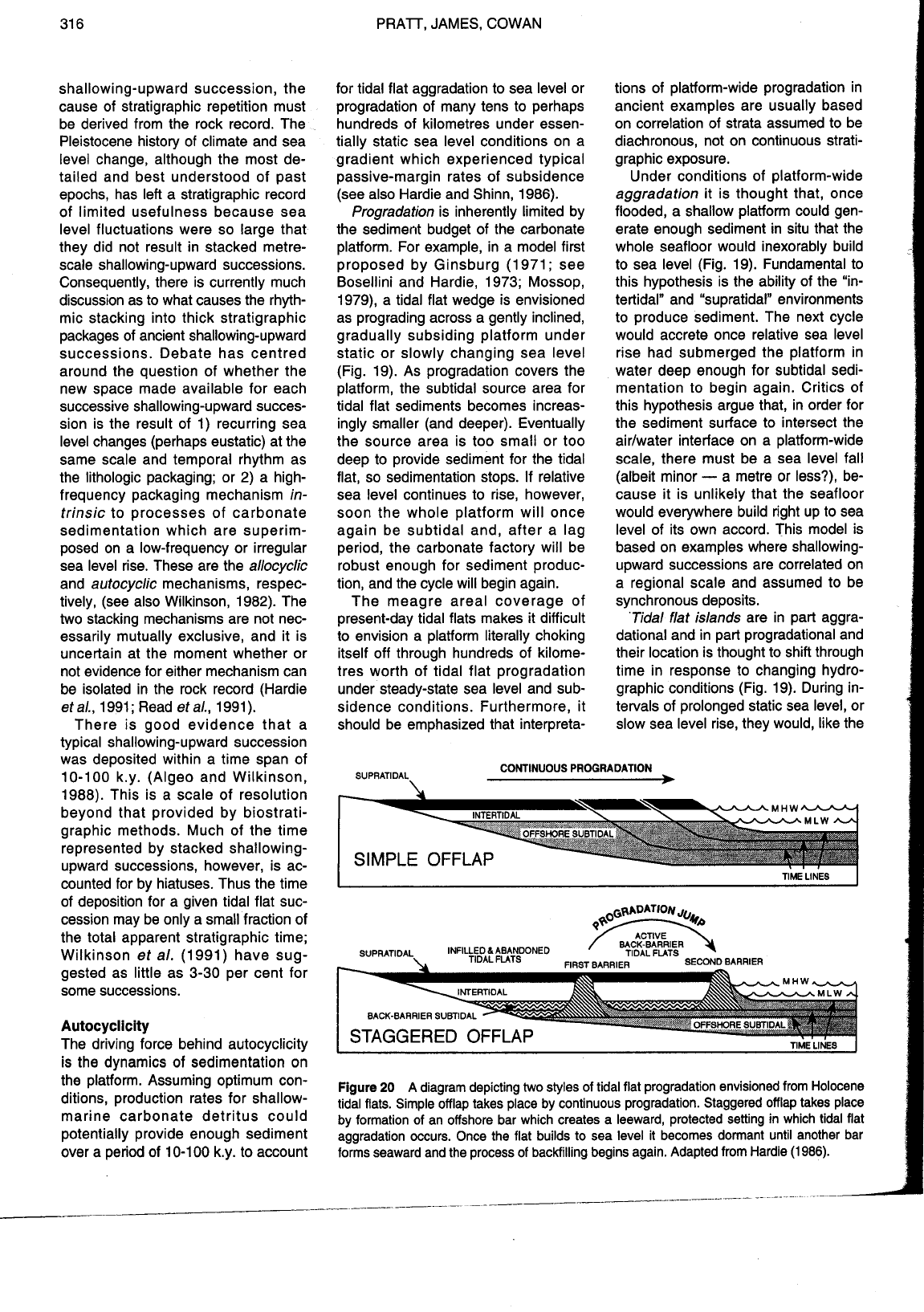
31
6
PRAlT, JAMES, COWAN
shallowing-upward succession, the
cause of stratigraphic repetition must
be derived from the rock record. The
Pleistocene history of climate and sea
level change, although the most de-
tailed and best understood of past
epochs, has left a stratigraphic record
of limited usefulness because sea
level fluctuations were so large that
they did not result in stacked metre-
scale shallowing-upward successions.
Consequently, there is currently much
discussion as to what causes the rhyth-
mic stacking into thick stratigraphic
packages of ancient shallowing-upward
successions. Debate has centred
around the question of whether the
new space made available for each
successive shallowing-upward succes-
sion is the result of 1) recurring sea
level changes (perhaps eustatic) at the
same scale and temporal rhythm as
the lithologic packaging; or
2)
a high-
frequency packaging mechanism in-
trinsic to processes of carbonate
sedimentation which are superim-
posed on a low-frequency or irregular
sea level rise. These are the allocyclic
and autocyclic mechanisms, respec-
tively, (see also Wilkinson, 1982). The
two stacking mechanisms are not nec-
essarily mutually exclusive, and it is
uncertain at the moment whether or
not evidence for either mechanism can
be isolated in the rock record (Hardie
etal., 1991; Read etal., 1991).
There is good evidence that a
typical shallowing-upward succession
was deposited within a time span of
10-100
k.y. (Algeo and Wilkinson,
1988). This is a scale of resolution
beyond that provided by biostrati-
graphic methods. Much of the time
represented by stacked shallowing-
upward successions, however, is ac-
counted for by hiatuses. Thus the time
of deposition for a given tidal flat suc-
cession may be only a small fraction of
the total apparent stratigraphic time;
Wilkinson et
a/. (1991) have sug-
gested as little as 3-30 per cent for
some successions.
Autocyclicity
The driving force behind autocyclicity
is the dynamics of sedimentation on
the platform. Assuming optimum con-
ditions, production rates for shallow-
marine carbonate detritus could
potentially provide enough sediment
over a period of 10-100
k.y. to account
for tidal flat aggradation to sea level or
progradation of many tens to perhaps
hundreds of kilometres under essen-
tially static sea level conditions on a
gradient which experienced typical
passive-margin rates of subsidence
(see also Hardie and
Shinn, 1986).
Progradation is inherently limited by
the sediment budget of the carbonate
platform. For example, in a model first
proposed by
Ginsburg (1971; see
Bosellini and Hardie, 1973; Mossop,
1979), a tidal flat wedge is envisioned
as prograding across a gently inclined,
gradually subsiding platform under
static or slowly changing sea level
(Fig. 19). As progradation covers the
platform, the
subtidal source area for
tidal flat sediments becomes increas-
ingly smaller (and deeper). Eventually
the source area is too small or too
deep to provide sediment for the tidal
flat, so sedimentation stops. If relative
sea level continues to rise, however,
soon the whole platform will once
again be
subtidal and, after a lag
period, the carbonate factory will be
robust enough for sediment produc-
tion, and the cycle will begin again.
The meagre areal coverage of
present-day tidal flats makes it difficult
to envision a platform literally choking
itself off through hundreds of
kilome-
tres worth of tidal flat progradation
under steady-state sea level and sub-
sidence conditions. Furthermore, it
should be emphasized that interpreta-
tions of platform-wide progradation in
ancient examples are usually based
on correlation of strata assumed to be
diachronous, not on continuous strati-
graphic exposure.
Under conditions of platform-wide
aggradation it is thought that, once
flooded, a shallow platform could gen-
erate enough sediment in situ that the
whole
seafloor would inexorably build
to sea level (Fig. 19). Fundamental to
this hypothesis is the ability of the "in-
tertidal" and "supratidal" environments
to produce sediment. The next cycle
would accrete once relative sea level
rise had submerged the platform in
water deep enough for
subtidal sedi-
mentation to begin again. Critics of
this hypothesis argue that, in order for
the sediment surface to intersect the
airlwater interface on a platform-wide
scale, there must be a sea level fall
(albeit minor
-
a metre or less?), be-
cause it is unlikely that the
seafloor
would everywhere build right up to sea
level of its own accord. This model is
based on examples where shallowing-
upward successions are correlated on
a regional scale and assumed to be
synchronous deposits.
'Tidal flat islands are in part aggra-
dational and in part progradational and
their location is thought to shift through
time in response to changing hydro-
graphic conditions (Fig. 19). During in-
tervals of prolonged static sea level, or
slow sea level rise, they would, like the
SUPRATIDAL
CONTINUOUS
PROGRADATION
>
SUPRATIDAL
INFILLED
6
ABANDONED
TIDAL FLATS
FIRST BARRIER
I
STAGGERED OFFLAP
Figure
20
A diagram depicting two styles of tidal flat progradation envisioned from Holocene
tidal flats. Simple
offlap takes place by continuous progradation. Staggered offlap takes place
by formation of an offshore bar which creates a leeward, protected setting in which tidal flat
aggradation occurs. Once the flat builds to sea level it becomes dormant until another bar
forms seaward and the process of backfilling begins again. Adapted from Hardie
(1986).

16. PERlTlDAL CARBONATES
prograding wedge, gradually choke off
local source areas, eventually be-
coming dormant. For sedimentation to
begin again after a period of local
stasis and probably protracted expo-
sure of supratidal flats, there must be
creation of new accumulation space.
Under conditions of more rapid long-
term sea level rise, and continually re-
newed accumulation space, the is-
lands would form a series of laterally
discontinuous peritidal units.
These autocyclic models express a
basic premise that pervades current
thinking about peritidal carbonates.
Persistent and ubiquitous stratigraphic
repetition of the basic shallowing-up-
ward succession seems to indicate
that these systems are,
at least in part,
intrinsically self-governing.
Allocyclicity
The extrinsic factors of subsidence and
eustacy, which cause relative sea level
change, have long been assumed to
exert strong control on
large-scale
peri-
tidal stratal patterns. High-frequency,
low-amplitude sea level changes, the
fourth- and fifth-order fluctuations of
sequence stratigraphy (Chapter 2), are
commonly invoked to drive the pack-
aging of metre-scale, shallowing-up-
ward peritidal successions (Grotzinger,
1986; Koerschner and Read, 1989;
Read
et a/.,
1991). In this situation, a
metre-scale rise in relative sea level
provides a
window of opportunity,
in
the sense of both time and accumula-
tion space, for the generation of a
single shallowing-upward succession
(Fig. 21). Deposition occurs while sea
level is rising and at its apex, and is ar-
rested by sea level fall.
Formation of the shallowing-upward
succession in this window is envisioned
in different ways by different workers.
All three styles of accretion presented
above are viable within this scheme
(prograding wedge, Grotzinger, 1986;
aggradation, Koerschner and Read,
1989; and tidal flat islands, Strasser,
1988). Extrinsically controlled
metre-
scale successions of many kinds, in-
cluding peritidal, have also been called
punctuated aggradational cycles
(PACs; Goodwin
et a/.,
1986) or more
recently
metre-scale allocycles
(Anderson and Goodwin, 1990). Such
cycles are metre-scale units, bounded
by surfaces of abrupt change to deeper
or disjunct facies and comprising a
suite of contemporaneous facies, all of
which shallow upward. The peritidal
portions of such cycles are thought to
be aggradational, but there is no
reason why they could not be
prograda-
tional (either wedges or islands).
The most commonly postulated ex-
ternal controls to drive, or at least reset,
the system at the end of each shal-
lowing-upward succession are rhythmic
eustatic change or jerky subsidence.
While spasmodic subsidence with the
required short frequency has been doc-
umented from seismically active areas
and for passive margins where
listric
SUPRATIDAL
INTERTIDAL
SUBTIDAL
f
EXPOSURE
Figure
21
A
diagram illustrating the relationship between fluctuating sea level and stacked
metre-scale, peritidal, shallowing-upward successions. Sea level rise provides a window of
opportunity for the succession to accrete as a prograding wedge, as a simultaneously
ag-
grading sheet or as tidal flat islands. Sea level fall terminates accretion and results in sub-
aerial exposure.
faulting is common (e.g., Cisne, 1986;
Hardie
et a/.,
1991), the importance of
subsidence rate changes as a control
on stratigraphic rhythmicity in peritidal
shallowing-upward successions is
unclear. Sudden base level drops have
not been observed in modern passive
margin platforms, and ancient
epeiric
settings, where much of the peritidal
record is found, seem unlikely to have
experienced metre-scale,
high-fre-
quency spasms of subsidence. Be-
cause there is currently no known
frequency to such
tectonism, it is difficult
to use, and as yet impossible to model
this mechanism as a universal control of
stratigraphic rhythmicity. Nevertheless,
the mechanism should not be dismissed
as a potential control, especially in
tec-
tonically active regimes (e.g., Fischer,
1964; Knight
etal.,
1991).
In the early to mid-1970s studies of
DSDP sediment cores and relict coral
reef terraces demonstrated that the
Pleistocene record of eustatic change
is one of superimposed orders of sea
level variation (orders, in the sense of
both magnitude and frequency; Chap-
ter 2). Deep sea sediments were ana-
lyzed for oxygen isotopes (as proxy to
glacial ice volume) and revealed a
long-term (100
k.y.), 100 m-scale,
asymmetric sea level oscillation.
Pleistocene fossil reef data suggested
that a shorter term (20
k.y.) sea level
oscillation was superimposed on the
longer term fluctuation. These various
orders of eustatic change have been
correlated to those predicted for ice-
house glaciation driven by celestial me-
chanics,
i.e., the Milankovitch rhythm
(e.g., Fischer, 1986). It has been
postu-
lated that the stratigraphic rhythmicity
apparent in ancient peritidal carbon-
ates reflects a similar
composite
eustasy
(Goldhammer
et al.,
1987),
both icehouse and greenhouse, of ce-
lestial origin. If astronomically forced
composite eustasy is indeed the
primary driver in the packaging of shal-
lowing-upward successions, then pre-
sumably modulation of various orders
of superimposed eustatic cycles could
have provided potentially limitless
rhythms to the stratigraphic record
(Bova and Read, 1987; Koerschner
and Read, 1989; Read
etal.,
1991).
The common challenge to
allo-
cyclicity is that extrinsic controls on
peritidal sedimentation are neither
demonstrable' in, nor theoretically
re-
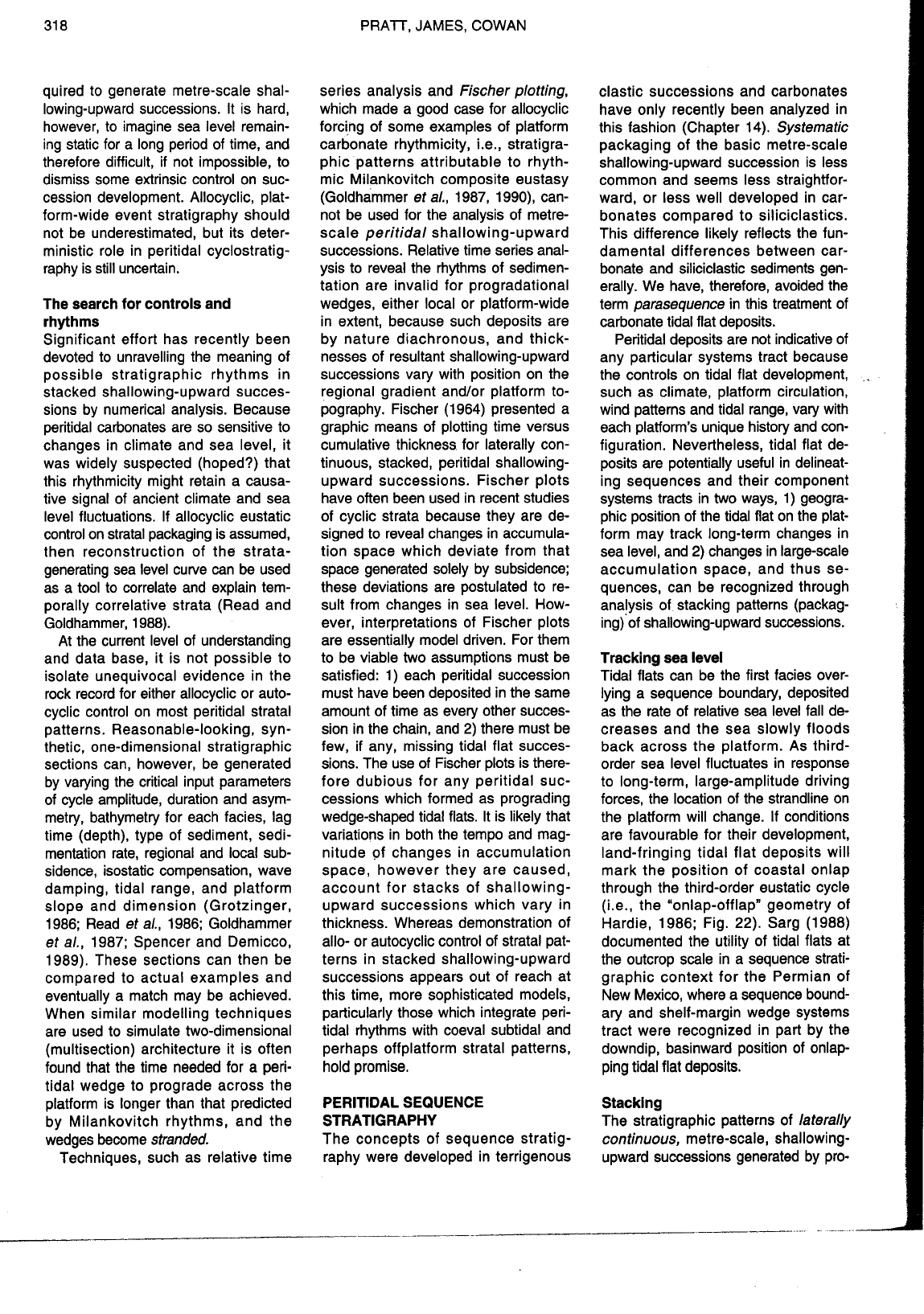
PRAT, JAMES, COWAN
quired to generate metre-scale shal-
lowing-upward successions. It is hard,
however, to imagine sea level remain-
ing static for a long period of time, and
therefore difficult, if not impossible, to
dismiss some extrinsic control on suc-
cession development. Allocyclic, plat-
form-wide event stratigraphy should
not be underestimated, but its deter-
ministic role in peritidal
cyclostratig-
raphy is still uncertain.
The search
for
controls and
rhythms
Significant effort has recently been
devoted to unravelling the meaning of
possible stratigraphic rhythms in
stacked shallowing-upward succes-
sions by numerical analysis. Because
peritidal carbonates are so sensitive to
changes in climate and sea level, it
was widely suspected (hoped?) that
this rhythmicity might retain a causa-
tive signal of ancient climate and sea
level fluctuations. If allocyclic eustatic
control on stratal packaging is assumed,
then reconstruction of the
strata-
generating sea level curve can be used
as a tool to correlate and explain tem-
porally correlative strata (Read and
Goldhammer, 1988).
At the current level of understanding
and data base, it is not possible to
isolate unequivocal evidence in the
rock record for either allocyclic or
auto-
cyclic control on most peritidal stratal
patterns. Reasonable-looking, syn-
thetic, one-dimensional stratigraphic
sections can, however, be generated
by varying the critical input parameters
of cycle amplitude, duration and asym-
metry, bathymetry for each facies, lag
time (depth), type of sediment, sedi-
mentation rate, regional and local sub-
sidence, isostatic compensation, wave
damping, tidal range, and platform
slope and dimension (Grotzinger,
1986; Read
et al.,
1986; Goldhammer
et a/.,
1987; Spencer and Demicco,
1989). These sections can then be
compared to actual examples and
eventually a match may be achieved.
When similar modelling techniques
are used to simulate two-dimensional
(multisection) architecture it is often
found that the time needed for a peri-
tidal wedge to
prograde across the
platform is longer than that predicted
by Milankovitch rhythms, and the
wedges become
stranded.
Techniques, such as relative time
series analysis and
Fischer plotting,
which made a good case for allocyclic
forcing of some examples of platform
carbonate rhythmicity,
i.e., stratigra-
phic patterns attributable to rhyth-
mic Milankovitch composite eustasy
(Goldhammer
et al.,
1987, 1990), can-
not be used for the analysis of
metre-
scale
peritidal
shallowing-upward
successions. Relative time series anal-
ysis to reveal the rhythms of sedimen-
tation are invalid for progradational
wedges, either local or platform-wide
in extent, because such deposits are
by nature diachronous, and thick-
nesses of resultant shallowing-upward
successions vary with position on the
regional gradient
and/or platform to-
pography. Fischer (1964) presented a
graphic means of plotting time versus
cumulative thickness for laterally con-
tinuous, stacked, peritidal shallowing-
upward successions. Fischer plots
have often been used in recent studies
of cyclic strata because they are de-
signed to reveal changes in accumula-
tion space which deviate from that
space generated solely by subsidence;
these deviations are postulated to re-
sult from changes in sea level. How-
ever, interpretations of Fischer plots
are essentially model driven. For them
to be viable two assumptions must be
satisfied:
1) each peritidal succession
must have been deposited in the same
amount of time as every other succes-
sion in the chain, and
2)
there must be
few, if any, missing tidal flat succes-
sions. The use of Fischer plots is there-
fore dubious for any peritidal suc-
cessions which formed as prograding
wedge-shaped tidal flats. It is likely that
variations in both the tempo and mag-
nitude of changes in accumulation
space, however they are caused,
account for stacks of shallowing-
upward successions which vary in
thickness. Whereas demonstration of
allo- or autocyclic control of stratal pat-
terns in stacked shallowing-upward
successions appears out of reach at
this time, more sophisticated models,
particularly those which integrate peri-
tidal rhythms with coeval
subtidal and
perhaps offplatform stratal patterns,
hold promise.
PERlTlDAL SEQUENCE
STRATIGRAPHY
The concepts of sequence stratig-
raphy were developed in terrigenous
clastic successions and carbonates
have only recently been analyzed in
this fashion (Chapter 14).
Systematic
packaging of the basic metre-scale
shallowing-upward succession is less
common and seems less straightfor-
ward, or less well developed in car-
bonates compared to
siliciclastics.
This difference likely reflects the fun-
damental differences between car-
bonate and siliciclastic sediments gen-
erally. We have, therefore, avoided the
term
parasequence
in this treatment of
carbonate tidal flat deposits.
Peritidal deposits are not indicative of
any particular systems tract because
the controls on tidal flat development,
such as climate, platform circulation,
wind patterns and tidal range, vary with
each platform's unique history and con-
figuration. Nevertheless, tidal flat de-
posits are potentially useful in delineat-
ing sequences and their component
systems tracts in two ways,
1) geogra-
phic position of the tidal flat on the plat-
form may track long-term changes in
sea level, and 2) changes in large-scale
accumulation space, and thus se-
quences, can be recognized through
analysis of stacking patterns
(packag-
ing)'of shallowing-upward successions.
Tracking sea level
Tidal flats can be the first facies over-
lying a sequence boundary, deposited
as the rate of relative sea level fall de-
creases and the sea slowly floods
back across the platform. As
third-
order sea level fluctuates in response
to long-term, large-amplitude driving
forces, the location of the strandline on
the platform will change. If conditions
are favourable for their development,
land-fringing tidal flat depasits will
mark the position of coastal
onlap
through the third-order eustatic cycle
(i.e., the "onlap-offlap" geometry of
Hardie, 1986; Fig. 22). Sarg (1988)
documented the utility of tidal flats at
the outcrop scale in a sequence strati-
graphic context for the Permian of
New Mexico, where a sequence bound-
ary and shelf-margin wedge systems
tract were recognized in part by the
downdip, basinward position of onlap-
ping tidal flat deposits.
Stacking
The stratigraphic patterns of
laterally
continuous,
metre-scale, shallowing-
upward successions generated by
pro-
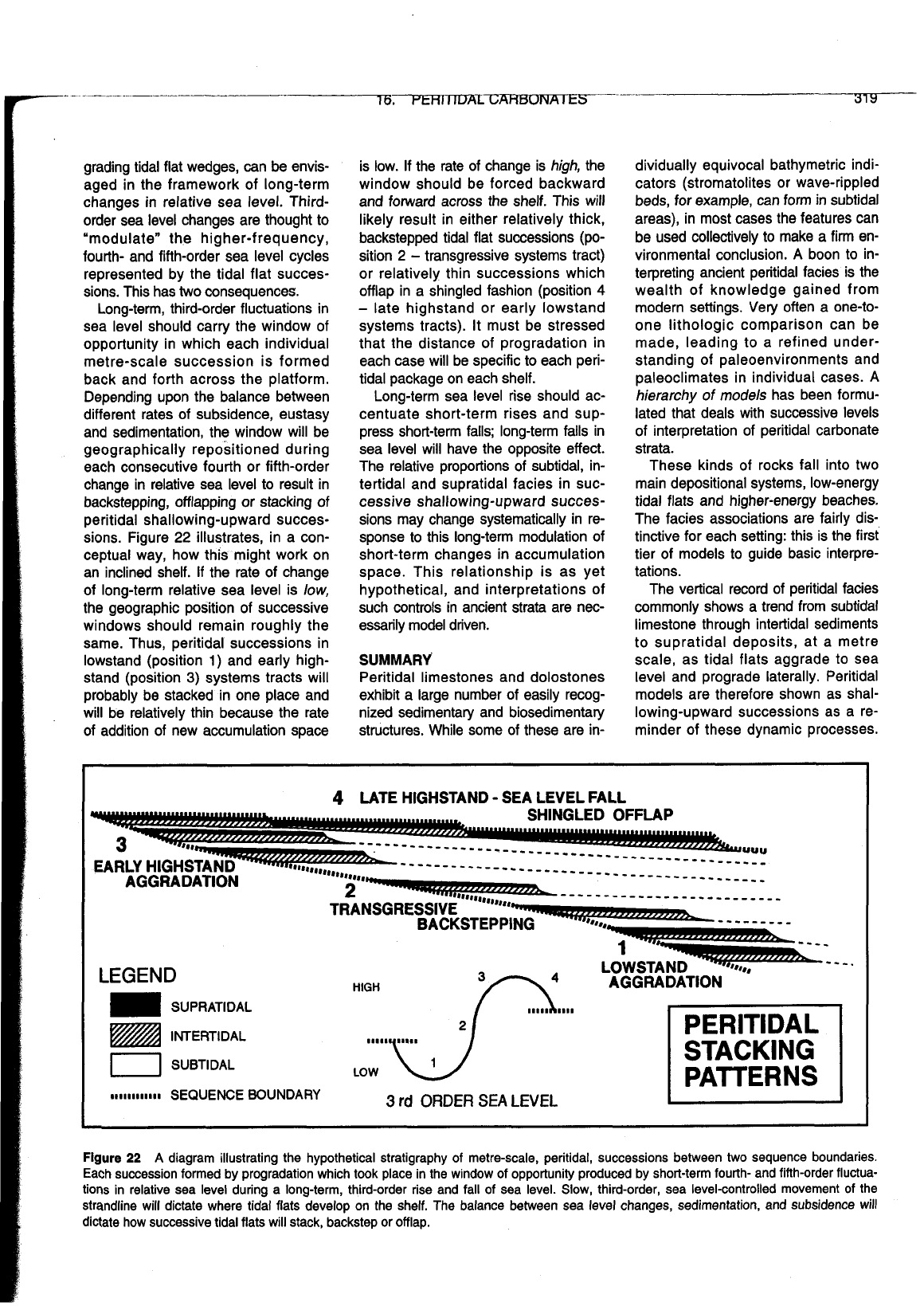
grading tidal flat wedges, can be envis-
aged in the framework of long-term
changes in relative sea level.
Third-
order sea level changes are thought to
"modulate" the higher-frequency,
fourth- and fifth-order sea level cycles
represented by the tidal flat succes-
sions. This has two consequences.
Long-term, third-order fluctuations in
sea level should carry the window of
opportunity in which each individual
metre-scale succession is formed
back and forth across the platform.
Depending upon the balance between
different rates of subsidence, eustasy
and sedimentation, the window will be
geographically repositioned during
each consecutive fourth or fifth-order
change in relative sea level to result in
backstepping, offlapping or stacking of
peritidal shallowing-upward succes-
sions. Figure
22
illustrates, in a con-
ceptual way, how this might work on
an inclined shelf. If the rate of change
of long-term relative sea level is low,
the geographic position of successive
windows should remain roughly the
same. Thus, peritidal successions in
lowstand (position
1)
and early high-
stand (position
3)
systems tracts will
probably be stacked in one place and
will be relatively thin because the rate
of addition of new accumulation space
is low. If the rate of change is
high,
the
window should be forced backward
and forward across the shelf. This will
likely result in either relatively thick,
backstepped tidal flat successions (po-
sition
2
-
transgressive systems tract)
or relatively thin successions which
offlap in a shingled fashion (position
4
-
late highstand or early lowstand
systems tracts). It must be stressed
that the distance of progradation in
each case will be specific to each
peri-
tidal package on each shelf.
Long-term sea level rise should ac-
centuate short-term rises and sup-
press short-term falls; long-term falls in
sea level will have the opposite effect.
The relative proportions of subtidal, in-
tertidal and supratidal facies in suc-
cessive shallowing-upward succes-
sions may change systematically in re-
sponse to this long-term modulation of
short-term changes in accumulation
space. This relationship is as yet
hypothetical, and interpretations of
such controls in ancient strata are nec-
essarily model driven.
SUMMARY
Peritidal limestones and dolostones
exhibit
a
large number of easily recog-
nized sedimentary and biosedimentary
structures. While some of these are in-
dividually equivocal bathymetric indi-
cators (stromatolites or wave-rippled
beds, for example, can form in
subtidal
areas), in most cases the features can
be used collectively to make a firm en-
vironmental conclusion.
A
boon to in-
terpreting ancient peritidal facies is the
wealth of knowledge gained from
modern settings. Very often a one-to-
one lithologic comparison can be
made, leading to a refined under-
standing of paleoenvironments and
paleoclimates in individual cases.
A
hierarchy
of models has been formu-
lated that deals with successive levels
of interpretation of peritidal carbonate
strata.
These kinds of rocks fall into two
main depositional systems, low-energy
tidal flats and higher-energy beaches.
The facies associations are fairly dis-
tinctive for each setting: this is the first
tier of models to guide basic interpre-
tations.
The vertical record of peritidal facies
commonly shows a trend from
subtidal
limestone through intertidal sediments
to supratidal deposits, at a metre
scale, as tidal flats aggrade to sea
level and
prograde laterally. Peritidal
models are therefore shown as
shal-
lowing-upward successions as a re-
minder of these dynamic processes.
4
LATE HIGHSTAND
-
SEA LEVEL FALL
--------___
-------___
--------
LEGEND
SUPRATIDAL
111111111111
SEQUENCE BOUNDARY
3
rd
ORDER SEA LEVEL
i
Figure
22
A diagram illustrating the hypothetical stratigraphy of metre-scale, peritidal, successions between two sequence boundaries.
Each succession formed by progradation which took place
in
the window of opportunity produced by short-term fourth- and fifth-order fluctua-
tions in relative sea level during
a
long-term, third-order rise and fall of sea level. Slow, third-order, sea level-controlled movement of the
strandline will dictate where tidal flats develop on the shelf. The balance between sea level changes, sedimentation, and subsidence will
dictate how successive tidal flats will stack,
backstep or offlap.

PRATT, JAMES, COWAN
These models, as predictors, point to
departures from the norm and other ir-
regularities that might have important
implications regarding intrinsic or ex-
trinsic controls on deposition. They
also provide a framework within which
the diagenesis of the sediment can be
tracked.
Peritidal carbonates occur repeti-
tively
in stratigraphic sequences,
often in a seemingly regular, or cyclic,
fashion. There is much debate about
whether these metre-scale, shallowing-
upward successions are platform-wide
responses to allogenic forces such as
spasmodic subsidence or episodic
eustasy, or whether they represent lo-
calized tidal flat shorelines and islands
shaped by autogenic,
i.e., hydrogra-
phic, controls. Sedimentologists have
their work cut out for them by these
models; we are now charged with the
job of deciding, if possible, which one
best explains our own successions, or
if a new approach is necessary. It is an
exciting field of research, one that
weds careful and precise field observa-
tions with increasingly sophisticated
numerical modelling.
ACKNOWLEDGEMENTS
This article is
an
outgrowth of several
research projects funded by the
Natural Sciences and Engineering
Research Council of Canada. An early
draft of the text was critically read by
E.C. Turner.
REFERENCES
Basic sources of information
Bathurst, R.G.C., 1975, Carbonate sedi-
ments and their diagenesis: Amsterdam,
Elsevier, 658 p.
Still a good
summaty of several modern
examples.
Ginsburg, R.N., ed., 1975, Tidal deposits: a
casebook of Recent examples and
fossil counterparts: New York, Springer-
Verlag, 428 p.
Many examples of both
siliciclastic and
carbonate tidal deposits.
Goldhammer, R.K., Dunn, P.A. and Hardie,
L.A., 1990, Depositional cycles, com-
posite sea-level changes, cycle stacking
patterns, and the hierarchy of strati-
graphic forcing: Examples from Alpine
Triassic platform carbonates: Geological
Society of America, Bulletin, v. 102,
p. 535-562.
Manipulation of sedimentological data
for computer models to show eustatic
effects on a shallow platform.
Hardie, L.A., ed., 1977, Sedimentation on
the modern carbonate tidal flats of
northwest Andros Island, Bahamas:
Johns Hopkins University, Studies in
Geology 22,202 p.
Carbonate tidal flat sediments and
biology in a humid setting.
Hardie, L.A. and Shinn, E.A., 1986,
Carbonate depositional environments,
modern and ancient. Part 3: tidal flats:
Colorado School of Mines, Quarterly, v.
81, 74 p.
The place to start, a thorough discus-
sion of peritidal carbonate sediments,
facies and depositional models.
Koerschner, W.F. and Read, J.F., 1989,
Field and modelling studies of Cambrian
carbonate cycles, Virginia Appala-
chians: Journal of Sedimentary Petrol-
ogy,
v. 59, p. 654-687
Lower Paleozoic
peritidal facies and
manipulation for computer models trying
to show controls by eustasy.
Logan, B.W., Hoffman, P. and Gebelein,
C.D., 1974, Evolution and diagenesis of
Quaternary carbonate sequences,
Shark Bay, Western Australia: American
Association of Petroleum Geologists,
Memoir 22, 358 p.
Carbonate tidal flat sediments, including
stromatolites, in a hypersaline setting.
Pratt,
B.R.
and James, N.P.,
1986,
The St
George Group (Lower Ordovician) of
western Newfoundland: tidal flat island
model for carbonate sedimentation in
shallow epeiric seas: Sedimentology, v.
33,
p. 31 3-343.
Lower Paleozoic facies and outline of
autocyclic island model.
Purser, B.H., ed., 1973, The Persian Gulf:
Holocene carbonate sedimentation and
diagenesis in a shallow epicontinental
sea: Heidelberg, Springer-Verlag, 47 p.
Description of carbonate peritidal sedi-
ments in an arid setting.
Shinn, E.A.,
1983a, Tidal flats, in Scholle,
P.A.,
Bebout, D.G. and Moore, C.H.,
eds., Carbonate depositional environ-
ments: American Association of
Petroleum Geologists, Memoir 33,
p. 171-210.
Read in conjunction with this article; a
colour-illustrated, review of carbonate
tidal flat sediments and
facies.
Tucker, M.E. and Wright, V.P., 1990,
Carbonate sedimentology: Oxford,
Blackwell, 482 p.
Succinct review of peritidal carbonate
sediments, facies and models.
Wilgus, C.K., Hastings, B.S.,
Posamentier,
H.W., Ross, C.A. and Kendall,
C.G.St.C., eds., 1988, Sea level
changes: an integrated approach:
Society of Economic Paleontologists
and Mineralogists, Special Publication
42,407 p.
Collection of papers emphasizing con-
ceptual basis of sequence stratigraphy
plus nimerous case studies of sea level
change from the geological record.
Other references
Algeo, T.J. and Wilkinson, B.W., 1988,
Periodicity of mesoscale Phanerozoic
sedimentary cycles and the role of
Milankovitch orbital modulation: Journal
of Geology, v. 96, p.
313-322.
Anderson, E.J. and Goodwin, P.W., 1990,
The significance of metre-scale allocy-
cles in the quest for a fundamental
stratigraphic unit: Journal of the
Geological Society of London, v. 147,
p. 507-518.
Beales, F.W., 1958, Ancient sediments of
Bahaman type: American Association of
Petroleum Geologists, Bulletin, v. 42,
p. 1845-1 880.
Belperio, A.P.,
Gostin, V.A., Cann, J.H. and
Murray-Wallace, C.V., 1988, Sediment-
organism zonation and the evolution of
Holocene tidal sequences in southern
Australia, in de Boer, P.L., van Gelder,
A. and Nio, S. D., eds., Tide-influenced
sedimentary environments and facies:
Dordrecht,
Reidel Publishing Company,
p.475-497.
Bertrand-Sarfati, J. and Moussine-
Pouchkine, A., 1988, Is cratonic sedi-
mentation consistent with available
models? An example from the Upper
Proterozoic of the West African craton:
Sedimentary Geology, v. 58, p. 255-276.
Bosellini, A. and Hardie, L.A., 1973,
Depositional theme of a marginal
marine evaporite: Sedimentology, v. 20,
p. 5-27.
Bottjer, D.J. and Ausich, W.I., 1986,
Phanerozoic development of tiering in
soft substrata suspension-feeding
com-
munities: Paleobiology, v. 12, p. 400-
420.
Bova, J.A. and Read, J.F., 1987, Incipiently
drowned facies within a cyclic peritidal
ramp sequence, Early Ordovician
Chepultepec interval, Virginia Appala-
chians: Geological Society of America,
Bulletin, v. 98, p. 714-727.
